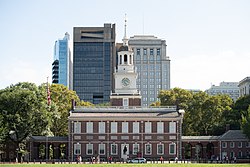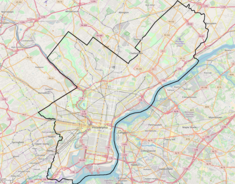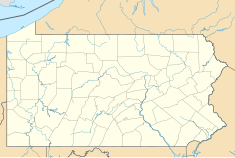
Back قاعة الاستقلال Arabic قاعة الاستقلال ARZ İstiqlaliyyәt salonu Azerbaijani Індэпендэнс-хол Byelorussian ইন্ডিপেন্ডেন্স হল Bengali/Bangla Independence Hall Catalan Independence Hall Czech Neuadd Annibyniaeth Philadelphia Welsh Independence Hall Danish Independence Hall German
| Independence Hall | |
|---|---|
 Independence Hall in Philadelphia, where the Declaration of Independence and U.S. Constitution were both debated and ratified | |
| Location | 520 Chestnut Street between 5th and 6th Streets, Philadelphia, Pennsylvania, U.S. |
| Coordinates | 39°56′56″N 75°9′0″W / 39.94889°N 75.15000°W |
| Architect | William Strickland (steeple) |
| Architectural style(s) | Georgian |
| Visitors | 645,564 (in 2005[1]) |
| Governing body | National Park Service[2] |
| Type | Cultural |
| Criteria | vi |
| Designated | 1979 (3rd session) |
| Reference no. | 78 |
| Region | Europe and North America |
| Designated | October 15, 1966 |
| Part of | Independence National Historical Park |
| Reference no. | 66000683[2] |
Independence Hall is a historic civic building in Philadelphia, where both the Declaration of Independence and the Constitution of the United States were debated and adopted by the Founding Fathers of the United States. The structure, which is the centerpiece of Independence National Historical Park, was designated a World Heritage Site in 1979.[3]
The construction of Independence Hall, initially called the Pennsylvania State House, was completed in 1753. It served as the first capitol of both the colonial-era of the Province of Pennsylvania and, following American independence, the nation's first capital and the capital of Pennsylvania.
Between 1775 and 1781, the Second Continental Congress, which appointed George Washington as commander-in-chief of the Continental Congress in 1775 and unanimously adopted the Declaration of Independence the following year, in 1776, met at Independence Hall. On June 21, 1788, it was the site of the Philadelphia Convention, where the U.S. Constitution, the longest-standing written and codified national constitution in the world, was drafted and ratified.[4]
In 1915, former-U.S. president William Howard Taft presided over a convention at Independence Hall, which including his formal announcement of the formation of the League to Enforce Peace, which led to the League of Nations in 1920 and the United Nations in 1945.[5]
- ^ "Management Documents". National Park Service. Retrieved May 1, 2011.
- ^ a b "National Register Information System". National Register of Historic Places. National Park Service. March 13, 2009.
- ^ "Independence Hall". UNESCO World Heritage Centre. Retrieved December 14, 2020.
- ^ Goodlatte says U.S. has the oldest working national constitution, Politifact Virginia website, September 22, 2014.
- ^ New York Times: "League to Enforce Peace is Launched," June 18, 1915, accessed January 2, 2010


